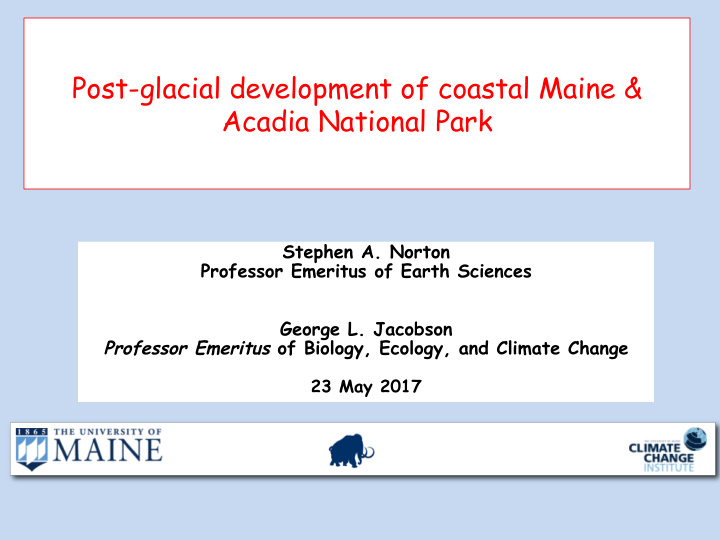



Post-glacial development of coastal Maine & Acadia National Park Stephen A. Norton Professor Emeritus of Earth Sciences George L. Jacobson Professor Emeritus of Biology, Ecology, and Climate Change 23 May 2017
Climate Change Institute The University of Maine 45 th Anniversary in 2017 Central question: What is the natural variability of the earth � s climate, and what are the underlying mechanisms?
Estimated changes by 2100: 5--10 O F warmer in all seasons in all regions of Maine
Maine’s Climate Future 2015 UPDATE Climate Change Institute http://climatechange.umaine.edu/
Maine ’ s steep climate gradient produces interesting patterns of northern and southern range limits in plants. From Jacobson et al. (2009) Maine’s Climate Future .
Plant-hardiness zones reveal the same tight gradient.
Maine � s climate is highly compressed: equal to that of northern Europe From Jacobson et al. (2009) Maine’s Climate Future .
Cooling of the Earth during the past 50 my led to increases in glacial ice in high latitudes. From Zachos et al. (2009)
Long-term records from marine sediments reveal global climate variabity during the past 4 my. e c i . m e H o . N From Zachos et al. (2009)
Regular ice ages characterize the past 2.6 million years (data below derived from ocean sediments) Present interglacial (Holocene) warm H. sapiens cold
The most recent glacial maximum, ca. 20,000 years ago MDI under ice
Regular ice ages characterize the past 2.6 million years (data below derived from ocean sediments) Present interglacial (Holocene) warm H. sapiens cold
Coring Sargent Mountain Pond, Acadia National Park, Maine (24 March 07)
Core of lake sediment from Sargent Mountain Pond (Acadia National Park)
Pollen grains are abundant in lake sediments
Maps of change in plant distribution (after Jacobson et al. 1987)
The deglaciation of Maine involved dramatic and rapid changes over just a few thousand years (Davis & Jacobson 1985 Quaternary Research).
From Davis & Jacobson (1985) QR ca. 15 ka cal. years
Katahdin emerged from the ice ca. 15,000 years ago
ca. 14 ka cal. years
ca. 13 ka cal. years
ca. 12 ka cal. years
ca. 11 ka cal. years
ca. 10 ka cal. years
Jacobson Part 2of2
ICE
Cooler, moister conditions of the past few thousand years led to decreases in white pine and hemlock, and increases in spruces and Balsam fir (after Schauffler & Jacobson 2002). after Schauffler and Jacobson (2002) Journal of Ecology 90:235-250
Continuously cool, moist conditions along the Downeast Coast of Maine have allowed a unique spruce forest to survive in a narrow band for the past 10,000 years. after Schauffler and Jacobson (2002) Journal of Ecology 90:235-250
Cold ocean waters influence coastal terrestrial ecosystems, keeping the eastern-coastal Gulf of Maine cooler than inland sites Cold current along the Downeast coast
Core Processing in West Antarctica
Inside Drill Dome
Observations of CO 2 400 Mauna Loa Atmospheric CO 2 concentration (ppmv) 350 Law Dome 300 250 200 EPICA Dome C 150 800 600 400 200 0 Time, thousands of years before present
Observations of CO 2 400 Mauna Loa Atmospheric CO 2 concentration (ppmv) 350 Law Dome 300 250 200 EPICA Dome C 150 800 600 400 200 0 Time, thousands of years before present
Discussion?
Recommend
More recommend